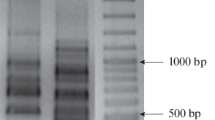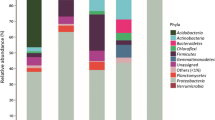Abstract
The microbiota of completely mixed soil slurry was acclimated with pentachlorophenol (PCP) or with a wood preservative mixture (WPM) containing several pollutants such as PCP and petroleum hydrocarbons. The impact of these compounds on the bacterial diversity was studied by using molecular tools. PCR amplifications of the 16S ribosomal RNA gene sequences (rDNA) were carried out with total DNA extracted from soil slurry samples taken at different time points during the enrichment process of the PCP and WPM reactors. The composition of these PCR products, reflecting the bacterial diversity, was monitored by the single-strand-conformation polymorphism (SSCP) method. Our results showed that the complexity of the SSCP profiles in the PCP reactor decreased significantly during the enrichment process, whereas they remained complex in the WPM reactor. PCR-amplified 16 rDNA libraries were generated from each reactor. The SSCP method was used to rapidly screen several clones of these libraries to find specific single-strand DNA migration profiles. In the PCP-activated soil, 96% of examined clones had the same SSCP profile, and sequences of representative clones were related to the genusSphingomonas, suggesting that the enrichment with PCP resulted in a selection of little phylogenetic diversity. Four different SSCP profiles were observed with the 68 examined clones from the WPM reactor. Representative clones of these profiles were related to Methylocystaceae or Rhizobiaceae, to sulfur-oxidizing symbionts, to the genusAcinetobacter, and to the genusSphingomonas. We also cloned and sequenced PCR-amplified DNA related to thepcpB gene, coding for theSphingomonas PCP-4-monooxygenase and detected in both reactors after two weeks of enrichment. Of the 16 examined clones, deduced amino acid sequences of 13 clones were highly related to theSphingomonas sp. strain UG30pcpB. The three remainingpcpB clones were not closely related to the three knownSphingomonas pcpB.
Similar content being viewed by others
References
Alexander M (1994) Biodegradation and Bioremediation. Academic Press, San Diego
Amann R, Ludwig W, Schleifer K-H (1995) Phylogenetic identification andin situ detection of individual microbial cells without cultivation. Microbiol Rev 59:143–169
Bakken LR, Olsen RA (1987) The relationship between cell size and viability of soil bacteria. Microb Ecol 13:103–114
Barbeau C, Deschênes L, Karamarev D, Corneau Y, Samson R (1997) Bioremediation of pentachlorophenol-contaminated soil by bioaugmentation using activated soil. Appl Microbiol Biotechnol 48:745–752
Bassam BJ, Caetano-Anollés G, Gresshoff PM (1991) Fast and sensitive silver staining of DNA in polyacrylamide gels. Anal Biochem 196:80–83
Bécaert V, Beaulieu M, Gagnon J, Villemur R, Deschênes L, Samson R (Submitted) Production from contaminated soil of an active consortium of microorganisms degrading pentachlorophenol and wood-preserving oil.
Becker PM (1999) About the order in aerobic heterotrophic microbial communities from hydrocarbon-contaminated sites. Int Biodeterioration Biodegradation 43:135–146
Berthelet M, Whyte LG, Greer CW (1996) Rapid, direct extraction of DNA from soils for PCR analysis using polyvinyl-polypyrrolidone spin columns. FEMS Microbiol Lett 138:17–22
Brenner DJ, Hollis DG, Moss CW, English CK, Hall GS, Vincent J, Radosevic J, Birkness KA, Bibb WF (1991) Proposal ofAfipia gen. nov., withAfipia felis sp. nov. (formerly the cat scratch disease bacillus),Afipia clevelandensis sp. nov. (formerly the Cleveland Clinic Foundation strain),Afipia broomeae sp. nov., and three unamed genospecies. J Clin Microbiol 29:2450–2460
Brunk CF, Avaniss-Aghajani E, Brunk CA (1996) A computer analysis of primer and probe hybridization potential with bacterial small-subunit rRNA sequences. Appl Environ Microbiol 62:872–879
Chaineau CH, Morel J, Dupont J, Bury E, Oudot J (1999) Comparison of the fuel oil biodegradation potential of hydrocarbon-assimilating microorganisms isolated from a temperate agricultural soil. Sci Total Environ 227:237–247
Crump BC, Armbrust EV, Baross JA (1999) Phylogenetic analysis of particle-attached and free-living bacterial communities in the Columbia river, its estuary, and the adjacent coastal ocean. Appl Environ Microbiol 65:3192–3204
Felsenstein J (1989) PHYLIP: Phylogeny Inference Package (Versino 3.2). Cladistics 5:164–166
Ferris MJ, Muyzer G, Ward DM (1996) Denaturing gradient gel electrophoresis profiles of 16S rRNA-defined populations inhabiting a hot spring microbial mat community. Appl Environ Microbiol 62:340–346
Godon JJ, Zumstein E, Dabert P, Habouzit F, Moletta R (1997) Molecular microbial diversity of an anaerobic digestor as determined by small-subunit rDNA sequence analysis. Appl Environ Microbil 63:2802–2813
Fewson CA (1988) Biodegradation of xenobiotics and other persistent compounds: the cause of recalcitrance. Trends Biotechnol 6:148–153
Goldstein JF, Mallory LM, Alexander M (1985) Reason for possible failure of inoculation to enhance biodegradation. Appl Environ Microbiol 50:917–983
Hayashi K (1991) PCR-SSCP: a simple and sensitive method for detection of mutations in the genomic DNA. PCR Methods Appl 1:34–38
Head IM, Saunders JR, Pickup RW (1998) Microbial evolution, diversity, and ecology: a decade of ribosomal RNA analysis of uncultivated microorganisms. Microb Ecol 35:1–21
Kimura M (1980) A simple model for estimating evolutionary rates of base substitutions through comparative studies of nucleotide sequences. J Mol Evol 16:111–120
Lebkowska M, Karwowska E, Miaskiewicz E (1995) Isolation and identification of bacteria from petroleum derivatives contaminated soil. Acta Microbiol Pol 44:297–303
Lee DH, Zo YG, Kim SJ (1996) Nonradioactive method to study genetic profiles of natural bacterial communities by PCR-single-strand-conformation polymorphism. Appl Environ Microbiol 62:3112–3120
Leung KT, Campbell S, Gan Y, White DC, Lee H, Trevors JT (1999) The role of theSphingomonas species UG30 pentachlorophenol-4-monooxygenase inp-nitrophenol degradation. FEMS Microbiol Lett 173:247–253
Liesack W, Janssen PH, Rainey FA, Ward-Rainey N, Stackebrandt E (1997) Microbial diversity in soil: the need for a combined approach using molecular and cultivation techniques. In: van Elsas JD, Trevors JT, Wellington EMH (eds) Modern Soil Microbiology. Marcel Dekker Inc, New York, pp 375–439
McAllister KA, Lee H, Trevors JT (1996) Microbial degradation of pentachlorophenol. Biodegradation 7:1–40
Moyer CL, Dobbs FC, Karl DM (1994) Estimation of diversity and community structure through restriction fragment length polymorphism distribution analysis of bacterial 16S rRNA genes from a microbial mat at an active, hydrothermal vent system, Loihi Seamount, Hawaii. Appl Environ Microbiol 60:871–879
Moyer CL, Tiedje JM, Dobbs FC, Karl DM (1996) A computer-simulated restriction fragment length polymorphism analysis of bacterial small-subunit rRNA genes: efficacy of selected tetrameric restriction enzymes for studies of microbial diversity in nature. Appl Environ Microbiol 62:2501–2507
Nüsslein K, Tiedje JM (1999) Soil bacterial community shift correlated with change from forest to pasture vegetation in a tropical soil. Appl Environ Microbiol 65:3622–3626
Orser CS, Lange CC (1994) Molecular analysis of pentachlorophenol degradation. Biodegradation 5:277–288
Otte M-P, Gagnon J, Comeau Y, Matte N, Greer C, Samson R (1994) Activation of an indigenous microbial consortium for bioaugmentation of pentachlorophenol/creosote contaminated soils. Appl Microbiol Biotechnol 40:926–932
Ovreas L, Jensen S, Daae FL, Torsvik V (1998) Microbial community changes in a perturbed agricultural soil investigated by molecular and physiological approaches. Appl Environ Microbiol 64:2739–2742
Pace NR (1996) New perspective on the natural microbial world: molecular microbial ecology. ASM News 62:463–470
Peters S, Koschinsky S, Schwieger F, Tebbe CC (2000) Succession of microbial communities during hot composting as detected by PCR-single-strand-conformation polymorphisms-based genetic profiles of small-subunit rRNA genes. Appl Environ Microbiol 66:930–936
Power M, van der Meer JR, Tchelet R, Egli T, Eggen R (1998) Molecular-based methods can contribute to assessments of toxicological risks and bioremediation strategies. J Microbiol Methods 32:107–119
Rheims H, Rainey FA, Stackebrandt E (1996) A molecular approach to search for diversity among bacteria in environment. J Ind Microbiol 17:159–169
Sambrook J, Fritsch EF, Maniatis T (1989) Molecular Biology, a Laboratory Manual, 2nd ed. Cold Spring Harbor Press, Cold Spring Harbor, NY
Sanger F, Nicklen S, Coulson AR (1977) DNA sequencing with chain terminating inhibitors. Proc Natl Acad Sci USA 74:5463–5467
Schwieger F, Tebbe CC (1998) A new approach to utilize PCR-single-strand conformation polymorphism for 16S rRNA gene-based microbial community analysis. Appl Environ Microbiol 64:4870–4876
Steffan RJ, Atlas RM (1991) Polymerase chain reaction: applications in environmental microbiology. Annu Rev Microbiol 45:137–161
Shuttlesworth KL, Cerniglia CE (1996) Bacterial degradation of low concentrations of phenanthrene and inhibition by naphthalene. Microb Ecol 31:305–317
Sullivan JP, Dickinson D, Chase HA (1998) Methanotrophs,Methylosinus trichosporium OB3b, sMMO, and their application to bioremediation. Crit Rev Microbiol 24:335–373
Torsvik V, Goksøyr J, Daae FL (1990) High diversity in DNA of soil bacteria. Appl Environ Microbiol 56:782–787
Ward N, Rainey FA, Goebel B, Stackebrandt E (1995) Identifying and culturing the “unculturables”: a challenge for microbiologists. In: Allsopp D, Colwell RR, Hawksworth DL (eds) Microbial diversity and ecosystem function. CAB International, Wallingford, United Kingdom, pp 89–110
Watanabe K, Teramoto M, Harayama S (1999) An outbreak of nonflocculating catabolic popuation caused the breakdown of a phenol-digesting activated-sludge process. Appl Environ Microbiol 65:2813–2819
Wild SR, Harrad SJ, Jones KC (1993) Chlorophenols in digested U.K. sewage sludges. Water Res 27:1527–1534
Wintzingerode FV, Göbel UB, Stackebrandt E (1997) Determination of microbial diversity in environmental samples: pitfalls of PCR-based rRNA analysis. FEMS Microbiol Rev 21:213–229
Zhao JS, Ward OP (1999) Microbial degradation of nitrobenzene and mono-nitrophenol by bacteria enriched from municipal activated sludge. Can J Microbiol 45:427–432
Author information
Authors and Affiliations
Corresponding author
Rights and permissions
About this article
Cite this article
Beaulieu, M., Bécaert, V., Deschênes, L. et al. Evolution of bacterial diversity during enrichment of PCP-degrading activated soils. Microb Ecol 40, 345–355 (2000). https://doi.org/10.1007/s002480000055
Received:
Accepted:
Issue Date:
DOI: https://doi.org/10.1007/s002480000055




